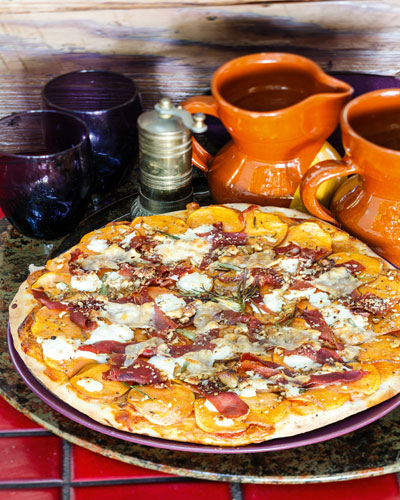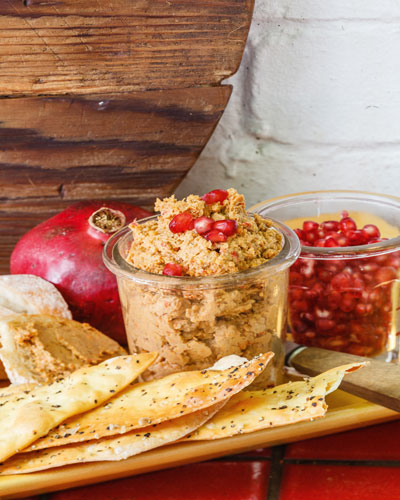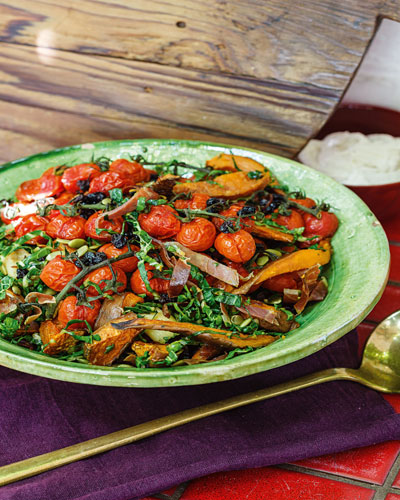
Orange, as distinct from white and purple sweet potato, the kumara (aka kumera), has been a staple food of Polynesians and the New Zealand Maori, possibly since the 14th century. It is thought that the sweet potato plant, Ipomomea batatas came to New Zealand from Hawaii, but originated in the Americas. The texture of the flesh of the kumara is smoother than that of the purple and white sweet potatoes, which are favoured in many parts of the world.
Selection and storage: Choose kumara that are firm with no blemishes or bruises. Store in a cool, dark, well-ventilated place. Do not refrigerate.
Kumara goes with: Rocket, capsicum, feta, parmesan, buffalo mozzarella, ham, prosciutto, roasted meats, pine nuts, pepitas, pecans, oranges, curry paste, balsamic vinegar, verjuice, maple syrup.
Recipes and styling Kay Francis
Photography Ken Brass
KUMARA SPREAD
Makes about 2 cups
1 kumara (about 375g)
1 tablesoon olive oil
1 cup walnuts
1 red chilli, halved and seeded
1 teaspoon ground cumin
1 teaspoon ground coriander
½ teaspoon ground cardamom
1 cup (250ml) natural full cream (Goat’s milk) yoghurt
1 tablespoon pomegranate molasses
½ pomegranate, seeds removed, for garnish
Preheat oven to 190ºC. Peel and cut kumara into chunks, place on an oven tray lined with baking paper, sprinkle with olive oil and roast about 30 minutes, or until tender. In the last 5 minutes add walnuts and chilli to the tray. Remove from oven and cool slightly. Place in a food processor with spices, yoghurt and pomegranate molasses and blend until smooth. Store refrigerated in an airtight container until required. Serve at room temperature, sprinkled with pomegranate seeds, as a spread with a selection of breads and crackers.
WARM KUMARA AND TOMATO SALAD
Serves 6
2 kumara, (about 750g), unpeeled and cut into wedges
1 tablespoon pumpkin seed oil (or olive oil)
1 head of garlic, halved through the equator
500g cherry truss tomatoes
100g prosciutto di Parma, cut into thin ribbons (see notes)
1 cup pepita (pumpkin seeds) roasted
3 cups finely shredded silverbeet leaves (white stalks discarded)
1 cup currants
Juice and finely grated rind of 2-3 lemons
Tahini dressing
1 cup full-cream goats’ milk yoghurt
1 cup tahini
Preheat oven to 190ºC. Place kumara on an oven tray lined with baking paper. Sprinkle with pumpkin seed or olive oil. Roast for 30 to 40 minutes, or until cooked and beginning to crisp. At the same time, place garlic, cut side down, and tomatoes onto another paper-lined tray and bake in oven with kumara. When almost done, add pepitas and prosciutto to tray of kumara and cook until prosciutto crisps. Combine all ingredients in a shallow salad bowl, carefully stir through shredded silver beet. Combine dressing ingredients, adding more lemon juice if the mixture is too thick. Serve dressing separately.
 KUMARA, GOATS CHEESE AND PROSCIUTTO PIZZA
KUMARA, GOATS CHEESE AND PROSCIUTTO PIZZA
Serves 2-3
1 store-bought thin pizza base
2 tablespoons Lebanese sfiha Sauce, or good tomato passata
1 tablespoon tahini
½ kumara, unpeeled, very thinly sliced
1 tablespoon grapeseed oil
½ teaspooon sea salt (or smoked sea salt)
100g goats’ cheese (or sliced buffalo mozzarella or feta)
100g thinly sliced prosciutto di Parma, cut into ribbons (see note)
2 tablespoons chopped roasted walnuts
2 sprigs rosemary, leaves only
100g Parmigiano-Reggiano (see notes)
Preheat oven to 190ºC. Spread pizza base with combined sfiha sauce and tahini. Arrange kumara in a single layer on top, then sprinkle with grapeseed oil and salt. Crumble goats’ cheese over kumara, then prosciutto di Parma, walnuts, rosemary leaves and Parmigiano-Reggiano. Bake in preheated oven for 20 minutes, or until base is crisp and kumara tender. Serve immediately.
NOTES:
Prosciutto di Parma is an all-natural product from the hills around Parma, Northern Italy, and has been made in the same simple way for years. Authentic Parma ham is identified by the Ducal crown on its packaging.
www.prosciuttodiparma.com.au
Parmigiano-Regiano is the authentic Parmesan cheese, handmade for more than 900 years, with no additives or preservatives, in a small region of Northern Italy encompassing Parma, Reggio, Emilia, Modena and Bologna. Its authenticity is identified by a pin dot stamp on the rind, and usually the name Parmigiano-Reggiano on the packaging. It is aged for a minimum of 12 months before use, but also 18, 22, 30 months or more.
www.parmigianorereggiano.com











